#York 1839
Text


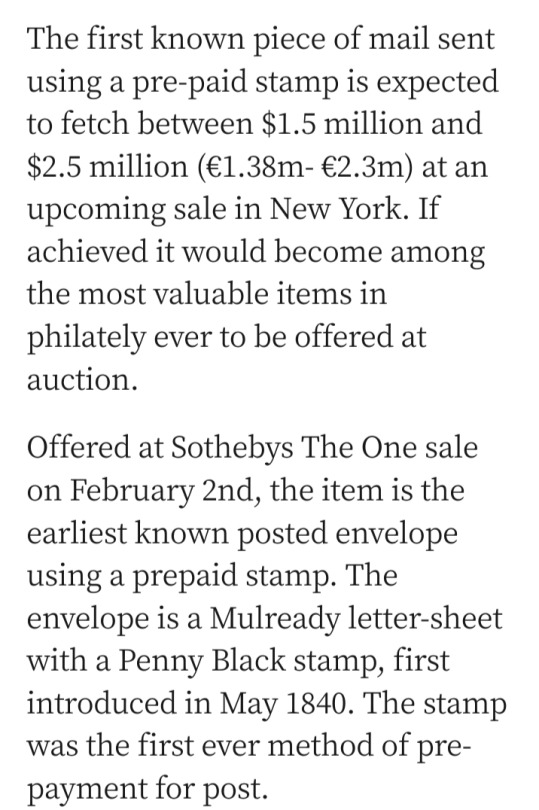


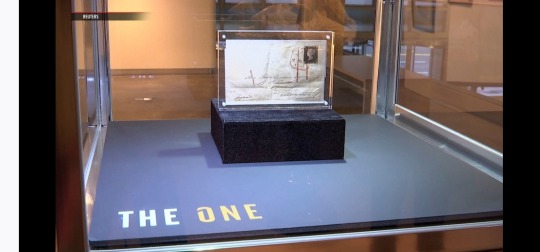

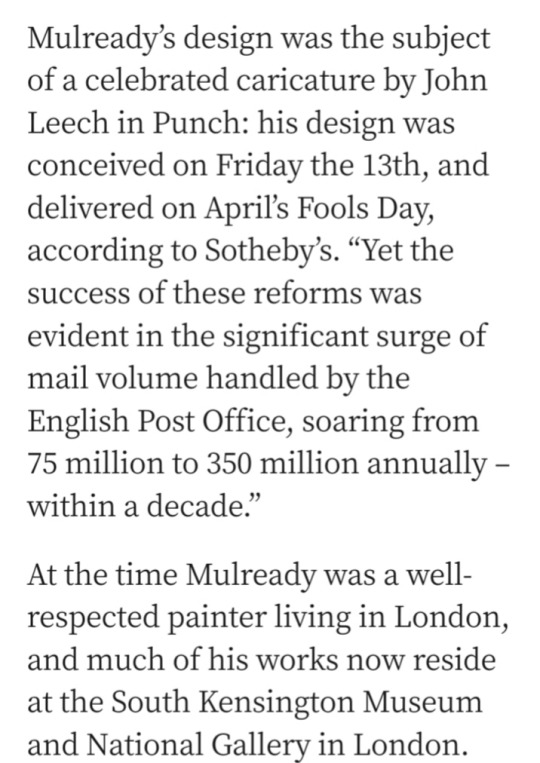
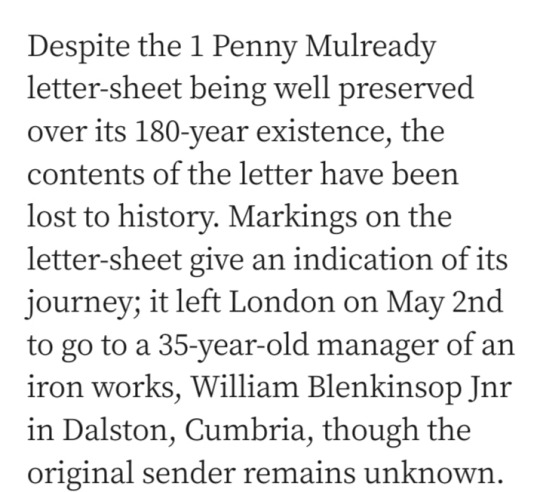

Source: Irishtimes
youtube
First piece of mail sent with postage stamp could fetch up to $2.5M at auction | ABS-CBN News
29 January 2024
The first known piece of mail sent using a postage stamp is about to hit the auction block at Sotheby's New York and could fetch up to $2.5 million.
— Report from Reuters
#Penny red stamp#Penny Black#posted envelope#prepaid stamp#William Mulready#Postage Reform Act of 1839#Mulready stationery#letters#postage stamps#John Leech#Ireland#Sotheby's New York#Youtube
0 notes
Text




Lovely lace designs.
The Lady’s Book. New York [etc: Godey Co. [etc.]., 1830
Feb. 1839
Godey’s Lady’s Book (Philadelphia, Pa. : 1840). Philadelphia, Pa: L.A. Godey, 1840.
May, 1841
Oct. 1854
AP2 .G56
#lace#lace making#sewing#clothing#design#art#embroidery#illustration#magazine#Godey's Lady's Book#Lady's Book#1800's#19th century#libraryofva#specialcollections#rarebooks
166 notes
·
View notes
Text
"the los angeles dodgers have signed yoshinobu yamamoto to a 12-year, $325 million contr-"
you bolt awake in cooperstown, new york. you are not online. it is 1839. you are abner doubleday, and you have changed your mind. the future cannot come to pass. baseball must burn.
74 notes
·
View notes
Text
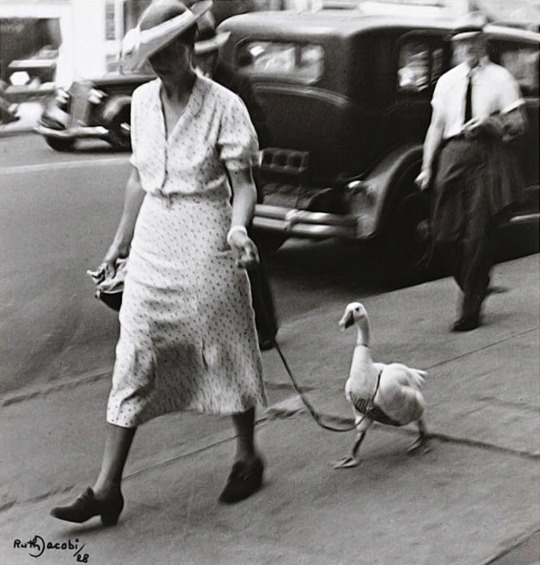
Ruth Jacobi, Spaziergängerin mit Gans, Humorous street snapshot from the Jewish Quarter of a woman walking a goose by the collar as if the fawl were her dog in the streets of New York City, 1928
Ruth Jacobi was the sister of Lotte Jacobi. Photography ran in the Jacobi family. Lotte and Ruth's great-grandfather, Samuel Jacobi, visited Paris between 1839 and 1842, where he obtained a camera, a license, and some instruction from L.J.M. Daguerre and then returned to Thorn to set up a studio. He prospered at his trade and eventually passed the business on to his son, Alexander. Alexander, in turn, handed the business down to his three sons, the eldest of whom was Lotte and Ruth's father, Sigismund.
Ruth Jacobi emigrated in 1935 to New York, where she opened a studio together with her sister Lotte Jacobi.
#ruth jacobi#Jewish Quarter#new york city#berlin#1928#weimar#weimar period#weimar era#geese#goose#lotte jacobi#streets of berlin#Atelier Jacobi#the atelier jacobi#20s new york#20s berlin#Spaziergängerin mit Gans#jew#jews#jewish people#studio#studio jacobi
93 notes
·
View notes
Text
In 1771, New York passed the Act to Confirm Certain Conveyances and Directing the Manner of Proving Deeds to Be Recorded, legislation gave white women some say in what their husband did with their assets.
In 1774, Maryland passed a similar law. It required a private interview between a judge and a married white woman to confirm her approval of any trade or sale by her husband of her property.
In 1787, Massachusetts passed a law allowing married white women, in limited circumstances, to act as femme sole traders, allowing them to conduct business on their own when their husbands were away.
In 1839, a Mississippi law passed giving white women the right to own enslaved Africans, just as white men were.
These are just some of the laws that allowed white women to be able to participate in the enslavement of Africans. This idea that white women have been completely beholden to white men and their whims, since the United States of America has existed, is just disingenuous revisionist history. White women have always been complicit in not just upholding white supremacy, but participating willfully.
19 notes
·
View notes
Text
https://x.com/AfricanArchives/status/1704567631515160830?s=20

Apart from Henry “Box” Brown, who mailed himself to freedom in a wooden box did you know there was a woman who also did the same?
Lear Green’s story is less well-known.
Green was an enslaved young woman who made one of history’s most daring and innovative escapes in order to marry the man she loved. Green was able to flee her slaveowner, James Noble, in an old wooden sailor’s chest during a long and arduous shipping journey from Baltimore to Philadelphia. Slaveholder and butter dealer Noble had “inherited” Green from his mother-in-law.
Green, born in 1839, was in her teens when she fell in love with a free Black man, William Adams, who asked her to marry him. Green initially refused because she did not want her children to be born into slavery. “How can I perform the duties of wife and mother while burdened by the shackles of slavery?” Green reportedly asked Adams. But Green later changed her mind after Adams and his mother, also a free woman, came up with a plan for her to escape.
Green, who was now determined to escape the oppression of slavery, purchased an old sailor’s chest and placed various items in it, including “a quilt, a pillow, and a few articles of raiment, with a small quantity of food and a bottle of water.”
Her fiance Adams and his mother fastened the chest with heavy rope, with Green cramped inside. Adam’s mother boarded an Ericsson steamboat in Baltimore and brought the chest with her. The chest was secured with rope and stowed with other freight. During the 18-hour journey to Philadelphia, Adams’ mother snuck into the compartment and from time to time lifted the lid of the chest to check in on Green and allow her a breath of fresh air.
After 18 hours in the chest, the ship arrived in Philadelphia. Green would meet with Underground Railroad conductor William Still before making her way further North to marry Adams and move to Canada. As expected, Green’s slaveowner Noble named her a fugitive slave, and a manhunt was launched to bring her back.
Noble reportedly posted an advertisement of her escape, which read as follows: “$150 REWARD. Ran away from the subscriber, on Sunday night, 27th inst., my NEGRO GIRL, Lear Green_about 18 years of age, black complexion, round featured, good looking and ordinary size… I have reason to be confident that she was persuaded by a negro man named Wm Adams…he had heard to say he was going to marry the above girl.”
Green and Adams married and settled in Elmira, New York. But their joy together was short-lived. After three years of marriage, Green suddenly died at the age of 21 for unknown reasons.
#Lear Green’s story is less well-known#Lear Green#Freedmen#Escapees#Freedom from enslavement#baltimore#philadelphia
44 notes
·
View notes
Text
Robe à l'anglaise (convertible to a polonaise)
American, ca. 1780; the silk English (Spitalfields), ca. 1770-75

Originally constructed as a formal robe à la française, this brocaded silk satin gown was modified around 1780 to update it into a robe à l'anglaise (also called a "nightgown" in England), part of a shift to more informal styles of the last quarter of the century. While the robe à la française with its loose flowing pleats extending from the upper back to the hem was worn over wide panniers, the bodice of the robe à l'anglaise fitted tightly into the small of the back ending in a deep point and the closely pleated skirts were supported by crescent-shaped pads with cork or horsehair, familiarly referred to as "bum rolls." Other changes made to the dress include a center-front edge-to-edge closing, rather than a stomacher to fill in the opening, and sleeves that cup the elbow and likely would have been accessorized with fine cotton or gauze cuffs, rather than the multiple pendant self-ruffles and lace engageants typical of the robe à la française. Additionally, at the time of its alteration, linen loops were stitched to the inside seams of the skirt in order that it could be drawn up into the exuberant swags of the robe à la polonaise, another fashionable style of the 1770s and 1780s.
Woven in Spitalfields, London, the ivory satin self-figured with diminutive sprigs and trailing vines and brocaded with sprays of roses and pansies and scattered blue flowers dates to about 1770 to 1775. Although many eighteenth-century dresses were altered 10 or even 20 years after the silk was produced, this example was reworked within just a few years. The soft drape of the lightweight fabric lent itself well to the more fitted construction of the new styles.
Provenance: The dress is believed to have been belonged to Catherine Beekman (1762-1839), wife of Elisha Boudinot (1749-1819), a lawyer and a New Jersey Supreme Court Justice from 1798 to 1804. Married in 1805, Beekman was Boudinot's third wife. A portrait of Catherine Beekman at age five by John Durand is in the collection of the New-York Historical Society (1962.73). An embroidered muslin dress with matching fichu, ca. 1798, also believed to have belonged to Catherine Beekman, is in the collection of the Metropolitan Museum of Art (1992.119.1a-c).
Cora Ginsburg
118 notes
·
View notes
Text
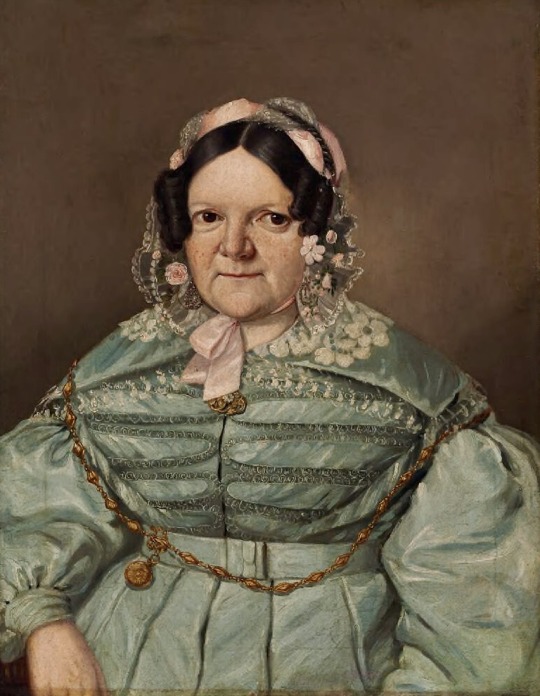
Unidentified Artist
Previously attributed to William Dunlap, American (Perth Amboy, NJ 1766 - 1839 New York, NY)
Title
Portrait of a Woman
Other Titles
Former Title: Anne Grant (1755-1838)
Harvard Art Museum
19 notes
·
View notes
Text
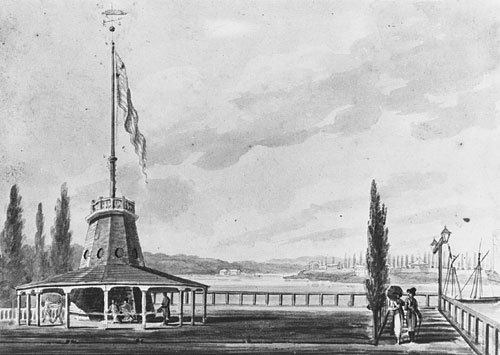
The Traveler's First View of New York painted by Pavel Svinyin (1787 - 1839)
#art#art history#artwork#culture#curators#history#museums#painting#romanticism#vintage#pavel svinyin
15 notes
·
View notes
Text

The mysterious Sailor's English Plum Pudding
Today something delicious and rather curios. But read for yourself. This story is listed by Dr. Chase in his book Dr. Chase's last receipt book and household physician. It tells how a plum pudding managed to save a ship in a storm at Christmas. Whether this story is really true is up to you to decide.
The Story:
It was about the stormiest voyage I have ever experienced. We left Hook on 5 November 1839 in a real storm and got into even worse weather off the Banks (Newfoundland), and it got dirtier with every mile we went. The old man was a bit gruff and anxious, and it wasn't easy to get on with him. This is not a Christmas story, and it has no moral. I was second mate and knew the captain quite well, but he was not very sociable, and the nearer we got to land after our billet (for we had no chance to make an observation), the grumpier he became.
On the 24th I was eating my dinner when the steward came in and said, "Captain, plum pudding tomorrow, as usual, sir?" It would be rude of me to echo the captain's reply, but the steward didn't care.
All night and the next day, December 25, it was a howling gale, and the captain remained on deck. At about 3 o'clock on Christmas Day dinner was ready, and it was very difficult to get the food from the galley into the cabin because the green sea was sweeping over the ship. The old man came down after a while and said, "Where's the pudding?"
Then the steward came in, pale as a ghost, and showing an empty bowl, said, "Washed overboard, sir." I need not repeat what the captain said. Somehow it looked as if the old man had tried to get a bit of courage with the pudding, and now there was none left.

I don't remember if it wasn't a passenger who said, "If only we could reach port safely, the pudding wouldn't matter in a storm like this." I think the old man would have liked to rip his head off for interfering with the ship's regulations.
At that moment the cook came into the cabin with a bowl in his hand and said, "There's another pudding. I've cut it in half," and he placed a nice big pudding on the table. Then the old man reached for the pudding and cut it into large pieces, helping the passenger last with a sort of triumphant look.
He had hardly swallowed a mouthful when the first mate came running up and said, "Lizard light on the starboard bow, and the weather is improving." "What's her course?" "East-north." "Then give her a full three points more north, sir, and praise the Lord." And the captain gulped down his pudding in three gulps, went on deck and said only, "I knew the pudding would do it," and left us.
Three days later we were in Liverpool, although nothing was ever heard of a ship that had left New York a day before us. - (https://archive.org/details/drchasesthirdlas01chas/page/332/mode/2up?q=plum+pudding)
You would also like to try this miracle pudding? Well then here it is have fun cooking it
Ingredients for Old English Plum Pudding Recipe:
6 ounces suet, skinned and finely cut
6 ounces raisins, seeded
6 ounces currents
3 ounces stale bread, crumbled
3 ounces flour, sifted
3 eggs
1 teaspoonful cinnamon
1/2 teaspoon nutmeg
1 teaspoon salt
1/2 pint milk
4 ounces white sugar
1/2 ounce candied angelica root (optional)
1/2 ounce candied citron
1/2 glass brandy (approx. 1/4 cup)
Sauce:
2 cups sugar
1/2 pint boiling water
2 cups sugar flavored with vanilla
Vanilla
2 tablespoons Flour or cornstarch
1 cup cold water
Butter, the size of an egg
2 to 3 tablespoons white vinegar or brandy or wine
Cinnamon, nutmeg, spices to flavor
57 notes
·
View notes
Text
Bonus Family
https://archiveofourown.org/works/51308236
by Wildi
Harley's life hasn't been easy. Ever since his father abandoned the family, he's had to shoulder responsibilities every single day. Tony Stark, his mentor, has tried to lend a helping hand, but Harley's mother, fueled by pride, refused any assistance.
Now, a glimmer of hope has emerged that could change everything. Harley has a shot at a scholarship that could be his ticket out of the small town of Rose Hill and a chance to make his mark in the bustling city of New York. The winds of change are blowing, and he's determined to seize this opportunity for a better future.
Words: 1839, Chapters: 1/?, Language: English
Fandoms: Iron Man (Movies), The Avengers (Marvel Movies)
Rating: Teen And Up Audiences
Warnings: No Archive Warnings Apply
Categories: F/M
Characters: Tony Stark, Pepper Potts, Harley Keener, Harley Keener's Sister, Harley Keener's Mother, Harley Keener's Father, Peter Parker, Aunt May Parker (Marvel)
Relationships: Pepper Potts/Tony Stark, Peter Parker & Tony Stark, Harley Keener & Peter Parker, Harley Keener & Tony Stark, Harley Keener & Peter Parker & Tony Stark, Harley Keener & Pepper Potts, Peter Parker & Pepper Potts
Additional Tags: Parent Tony Stark, Tony Stark Acting as Peter Parker's Parental Figure, Tony Stark Acting as Harley Keener's Parental Figure, Pepper Potts Acting as Peter Parker's Parental Figure, Pepper Potts Acting as Harley Keener's Parental Figure, Parent Pepper Potts, Harley Keener & Peter Parker Friendship, Harley Keener-centric
read it on AO3 at https://archiveofourown.org/works/51308236
6 notes
·
View notes
Text

Andrew Harris, (1810-1841), graduated from the University of Vermont in 1838. One year later in an address delivered to nearly five thousand abolitionists at New York City’s Broadway Tabernacle on May 7, 1839, he argued that slavery in the South influenced racism in the North. He was mindful of his situation, having been denied admission to Union and Middlebury Colleges because of his race.
He began his college search at a time when the abolition movement was at its height, and according to Thornton, had aspirations to “preach the gospel to an underserved population.”
He became a UVM student when every other school rejected him and paid a dollar initiation fee to enter as a sophomore in November 1835. But his time in Burlington wasn’t easy. He was not listed in the catalog of students (1835-38). Despite the presence of a tiny anti-slavery minority, the segregationist impulse and hostility among the majority of his classmates lasted until the very end.
He was forced to accept his diploma offstage due to pushback from his 23 classmates. He left Burlington for Philadelphia after graduating fourteenth in his class in 1838.
He wasted little time establishing himself as a powerful voice of the abolitionist movement in Philadelphia and became involved in every way he could.
His influence continued to grow after becoming a Presbyterian minister in April 1841, and he served as the pastor of Philadelphia’s St. Mary’s Street Church, commanding respect from Black and white clergymen.
He died of fever less than one year later, but not before going down in history as the first African American college graduate to publicly call for an end to slavery and full equality for all African Americans. #africanhistory365 #africanexcellence
2 notes
·
View notes
Text
Selkirk Lighthouse
Richland, New York, United States
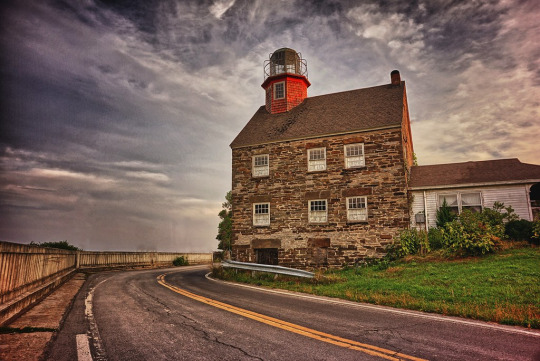
Source: Flickr
Constructed: 1839
Automated: 1989
Fun Fact: It is one of four lighthouses in the United States to still have its original bird-cage lantern.
Have a favorite lighthouse? Curious about lighthouses in general? Send an ask!
10 notes
·
View notes
Text
Written as a poem in 1818 by pastor Joseph Mohr of the St. Nicolaus Kirche in Oberndorf (Austria). His organist Franz Gruber wrote the music. Together they sang it during mass on Christmas eve, accompanied on guitar as the organ didn't function. For three years the song Stille Nacht Heilige Nacht was only heard in this tiny Tirolian place. Organ builder Karl Mauracher from Fügen was the first outstander who heard the song while fixing Gruber's pipe organ and he took the sheet music home. In 1831 Mauracher arranged it for choir. Four children of the Strasser family sang it in 1832 on the well visited Leipziger Messe. There they got an invitation to come and sing it in Vienna during next Christmas eve, attended by the royal family. That's how it got known all over. In 1839 another family choir sang it in New York.
Merry Christmas Everyone
#Ernestine Schumann-Heink#contralto#dramatic contralto#opera singer#classical singer#aria#opera#bel canto#classical#classical studies#classical music#SILENT NIGHT#Silent Night#Christmas carol#Christmas#Stille Nacht#heilige Nacht#Holy Night#Christmas Eve#singer
26 notes
·
View notes
Text
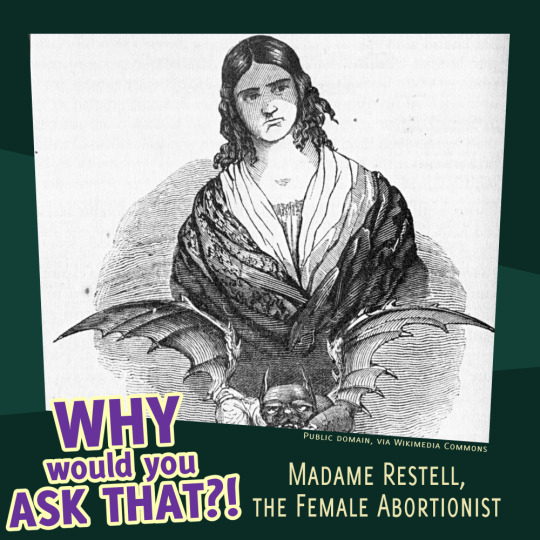
[image: Madame Restell, or Ann Lohman, as depicted in the 13 March 1847 edition of the National Police Gazette. It is in the linocut style, with a pensive woman with a shaded face. A demon hovers under her, eating a baby. The baby eating part has been cut off.]
Madame Restell is a famed abortionist from New York, starting her trade first as a seamstress before beginning her business as a female physician, providing abortifacients to those in need of her services.
Here's an ad she ran in the New York Sun in 1839:
TO MARRIED WOMEN.—Is it not but too well known that the families of the married often increase beyond what the happiness of those who give them birth would dictate?… Is it moral for parents to increase their families, regardless of consequences to themselves, or the well being of their offspring, when a simple, easy, healthy, and certain remedy is within our control? The advertiser, feeling the importance of this subject, and estimating the vast benefit resulting to thousands by the adoption of means prescribed by her, has opened an office, where married females can obtain the desired information.
Go listen to episode 66 >>
4 notes
·
View notes
Text

JOHN HENRY HILL
New York, 1839 - 1922
Rabbits and fox
Signed H Hill at the bottom right
Oil on canvas
Wannenes
18 notes
·
View notes